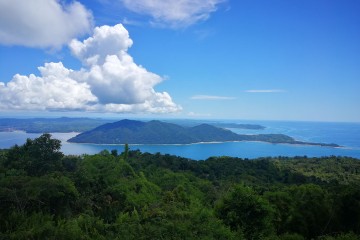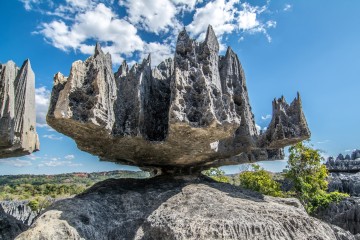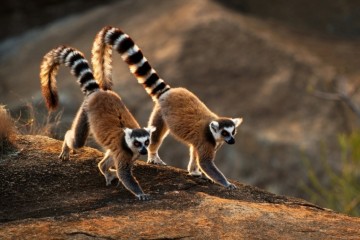
Classic Madagascar
Experience a captivating Southern journey featuring exploration of Ranomafana National Park, the Anja Reserve, and Isalo National Park.
Nestled off the southeastern coast of Africa, this extraordinary destination beckons you to uncover its diverse landscapes and encounter the countless endemic species that call it home.
From playful lemurs and colorful chameleons to exotic birds and endemic flora, Madagascar is a paradise for nature enthusiasts and wildlife lovers.
Madagascar’s spectacular National Parks offer a rare opportunity to witness its remarkable creatures in their natural habitat, including agile reptiles, intriguing insects and unique plant species. Playful ring-tailed lemurs are a delight to observe as they leap from rock to rock and interact with their social groups.
As well as being a biodiversity hotspot, where more than 90% of plant and animal species on the island are found nowhere else on Earth, every corner of Madagascar is filled with stunning landscapes that will take your breath away. Explore rugged canyons, lush rainforests, mist-covered mountains, jagged limestone pinnacles and the turquoise waters of the Indian Ocean.
Trek through Madagascar’s dense jungles, listening to a symphony of bird song and the haunting calls of lemurs, and spot colorful chameleons and rare birds. From the endearing to the elusive, the wildlife of Madagascar is endlessly captivating.
Prepare to embark on an unforgettable journey as you explore Madagascar's lush rainforests, breathtaking coastlines, and delve into its renowned national parks, where a fascinating array of wildlife awaits your discovery. Let us help you plan your ultimate Madagascar adventure today!
Madagascar is generally considered a safe destination for tourists. The country has a relatively low crime rate, and the majority of visitors to Madagascar experience a trouble-free stay.
The currency of Madagascar is the Malagasy Ariary (MGA). It's important to note that while the Ariary is the official currency, some businesses, particularly those catering to tourists, may accept major foreign currencies such as the US Dollar or Euro. However, it's advisable to carry and use the local currency for most transactions to ensure fair pricing and avoid potential issues with currency exchange.
The official languages of Madagascar are Malagasy and French.
Malagasy, an Austronesian language, is spoken by the majority of the population and serves as the national language. There are several dialects of Malagasy spoken throughout the country, with slight variations in vocabulary and pronunciation.
French, inherited from Madagascar's colonial past, is widely used in education and business. It is primarily spoken by the older generation and those in formal settings. Many signs, official documents, and educational materials are written in both Malagasy and French.
English is also spoken to some extent in tourist areas, hotels, and by individuals working in the tourism industry.
The best time to visit Madagascar is generally during the dry season, which runs from April to November. However, Madagascar's diverse climate and ecosystems mean that different times of the year offer unique experiences.
Mid-April to May: This period marks the end of the rainy season, leaving the landscapes lush and vibrant. It’s an excellent time for wildlife viewing, as animals are more active.
June to September: These months are cooler and drier, with pleasant temperatures and lower humidity—ideal for exploring national parks, trekking, and other outdoor activities. However, the east experiences a rainy period from June to mid-September, with light but frequent showers. From July to September, humpback whales migrate along the coast, making it a great time for whale watching.
October to November: As the dry season comes to an end, temperatures begin to rise. The landscapes in the South and West can appear dry and parched from September to November.
January to mid-April: This is the rainy season, with some regions experiencing heavy rainfall and cyclones, which can impact accessibility and outdoor activities.
Whale shark diving: The best time for divers to see whale sharks is from October to December.
Lemur birthing season: Most lemurs give birth between September and November.
Birdwatching: The best time for birdwatching is from October to December, during the breeding season when birds are more active and visible around their nests.
Most tours can be done year-round, except:
Tsingys of Bemaraha in the West, only from late May until early November
Deep South between Toliara and Fort Dauphin and the road from Morondava via Manja to Morombe, only May to October.
The Ivato International Airport (TNR) in Antananarivo, the capital city of Madagascar, is the main international gateway. Several airlines offer direct flights to Antananarivo from various cities around the world, including major hubs in Africa, Europe, and the Middle East.

Experience a captivating Southern journey featuring exploration of Ranomafana National Park, the Anja Reserve, and Isalo National Park.

Unveil the natural wonders of northern Madagascar. From the verdant Montagne d'Ambre and dramatic Ankarana to the enchanting tropical isle Nosy Be.

A magical journey through Morondava, Kirindy, and Bekopaka. Witness the surreal stone forest landscape of Tsingy de Bemaraha and iconic Baobab Alley!

Small Group Tours: Embark on an escorted small group tour to discover the stunning continents of South America, Africa, Antarctica and New Zealand. A group tour gives you the opportunity to explore in a fun and exciting environment surrounded by like-minded travellers.
Uncover the wonders of Madagascar on an 18-day small group tour through vibrant cities, lush rainforests, and stunning coastlines.

Explore the untouched wilderness of Masoala, known for its rich biodiversity, pristine rainforest, and stunning coastlnes